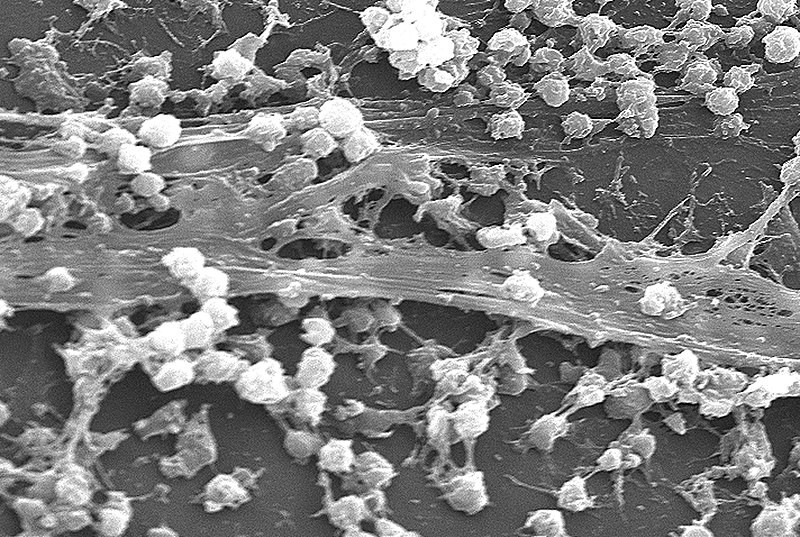Once left to their own devices, bacteria on our teeth or wounded skin can encase themselves in slimy accumulations and turn into biofilm. Once established, these biofilms are difficult to eradicate due to the presence of an extracellular matrix that protects them from antibiotic medication. As a result, these bacteria can wreak havoc on our tissue.

(Photo: Wikimedia Commons/ MarcoTolo)
Biofilm-Associated Infections
Biofilms are linked to many health issues in humans, such as chronic wound infections and tooth decay. Inside the mouth, they are known as plaques, the assemblages formed by bacteria like Streptococcus mutans that cause tooth decay. Meanwhile, wound infections, commonly caused by Staphylococcus bacteria, can delay healing.
In either case, biofilms containing densely packed networks of proteins and carbohydrates can prevent antibiotics from reaching bacteria throughout the affected area. Biofilms are not only difficult to remove but also troublesome to discern.
A Novel Technique in Destroying Biofilms
A new technique has been developed by scientists, which can provide a simple way to destroy the muck and kill the bacteria. Experts from the University of Pennsylvania and Stanford University have created sugar-coated gold nanoparticles that can be used to image and destroy biofilms. Their research findings are discussed in the paper "Theranostic gold-in-gold cage nanoparticles enable photothermal ablation and photoacoustic imaging in biofilm-associated infection models."
Led by Maryam Hajfathalian, professor of biomedical engineering at the New Jersey Institute of Technology, the research team demonstrated the diagnostic and therapeutic potential of the nanoparticles on the teeth and wounded skin of rats and mice. They could eliminate the biofilms in just one minute, even outperforming conventional antimicrobials.
According to Division of Discovery Science & Technology program director Luisa Russell, the new platform allows experts to burst biofilms without surgically debriding infections, which can be crucial when using antibiotics. The method can also treat patients who are either allergic to antibiotics or infected by bacterial strains with resistance to medication.
Gold is a nontoxic element that readily converts light energy into thermal energy. This property makes gold a prime candidate for photothermal therapy, which utilizes nanoparticle heat to kill surrounding pathogens. Aside from generating heat, the nanoparticles also emit detectable ultrasound waves in response to light. This means that gold particles can be visualized using a photoacoustic imaging technique.
In this study, gold spheres are encapsulated within larger golden cage-shaped nanoparticles for optimized light response for imaging and therapeutic purposes. The nanoparticles are also coated with dextran, a carbohydrate that is a common building block of biofilms, to make them more appealing to bacteria.
To test the effectiveness of the new platform, the researchers applied the gold nanoparticles atop rat teeth infected with Streptococcus mutans. A photoacoustic imaging test revealed that the nanoparticles emitted signals that came through loud and clear. This allowed the scientists to observe where biofilms had removed the dextran-coated particles on the teeth.
Next, the team irradiated the teeth with a laser to evaluate the nanoparticles' therapeutic effect. They also treated other infected teeth samples with the topical antiseptic chlorhexidine for comparison. A stark contrast was observed in the outcomes of the two treatments, with the photothermal therapy almost 100% effective at eliminating biofilms. Meanwhile, chlorhexidine did not significantly reduce the viability of bacteria.
The new method is also fast for oral infection. Although the laser was applied for one minute, it killed all the bacteria in just 30 seconds.
RELATED ARTICLE: US Army To Harness the Potential of Biofilms in Fighting Corrosive Bacteria That Destroy Aircraft Fuel Tanks
Check out more news and information on Biofilm in Science Times.



![Earth's Quasi-Moon Kamo‘oalewa Could Originate From Lunar Surface Not Asteroid Belt [Study]](https://1721181113.rsc.cdn77.org/data/thumbs/full/53275/89/56/50/40/earths-quasi-moon-kamo-oalewa-could-originate-from-lunar-surface-not-asteroid-belt-study.png)










